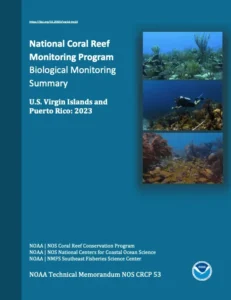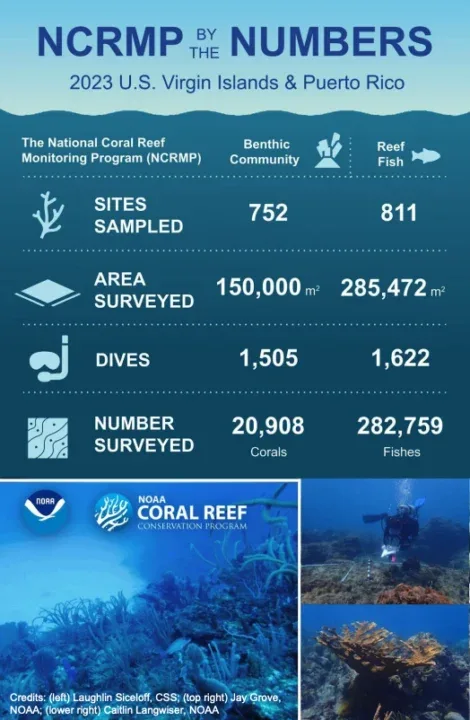 The National Oceanic and Atmospheric Administration (NOAA) has released a summary of its 2023 coral reef monitoring activities in Puerto Rico and the U.S. Virgin Islands (USVI), conducted through its National Coral Reef Monitoring Program (NCRMP). This ongoing effort tracks the health of coral reefs by collecting biological data on fish populations, coral species, and benthic communities.
The National Oceanic and Atmospheric Administration (NOAA) has released a summary of its 2023 coral reef monitoring activities in Puerto Rico and the U.S. Virgin Islands (USVI), conducted through its National Coral Reef Monitoring Program (NCRMP). This ongoing effort tracks the health of coral reefs by collecting biological data on fish populations, coral species, and benthic communities.
The 2023 fieldwork took place in St. Croix from June 5–16, in St. Thomas and St. John from August 7–18, and across Puerto Rico from June 14 to November 16. The surveys were a collaborative effort involving multiple local and regional partners, including the National Park Service, University of the Virgin Islands, and the Puerto Rico Department of Natural and Environmental Resources.

Key Findings
Coral and Benthic Communities
The report highlights a continued decline in coral cover, primarily due to the spread of stony coral tissue loss disease (SCTLD). Coral cover has dropped by 33% – 59% across the region since NCRMP began monitoring in 2013. In particular, areas like St. Thomas/St. John and Puerto Rico have seen persistently low coral cover since 2019, while declines in St. Croix have been apparent since 2021.
The most common corals identified were fast-growing, stress-tolerant species such as Porites astreoides, Agaricia agaricites, and Siderastrea siderea, which contribute less to reef-building. Additionally, researchers observed a shift toward smaller coral colonies, especially among species highly vulnerable to SCTLD.
Fish Communities
NCRMP also reported stable and analysable data on 22 – 50 reef fish species, both targeted and non-targeted by fisheries. Regional differences were noted in grouper species presence, with red hind (Epinephelus guttatus) most common in St. Thomas/St. John and coney (Cephalopholis fulva) more frequent in St. Croix and Puerto Rico. Redband parrotfish (Sparisoma aurofrenatum) was the most prevalent parrotfish across all areas.
Non-target species such as bicolor damselfish (Stegastes partitus) and bluehead wrasse (Thalassoma bifasciatum) dominated reef fish communities throughout the region.
Supporting Reef Management
The NCRMP data supports coral and fish population management strategies, informs conservation policies, and complements local monitoring initiatives. This comprehensive regional report provides valuable insights for protecting and restoring vulnerable coral reef ecosystems in U.S. Caribbean waters.
Source: NOAA Report
